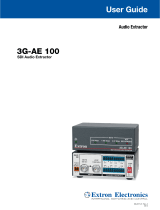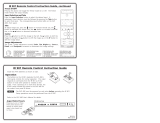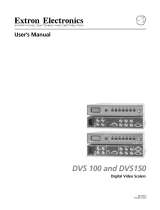
Contents
Introduction ...............................................1
DVS 605 Series Description ................................. 1
Licensed Third-Party Software Used in
the DVS 605 ....................................................... 2
Key Features ....................................................... 3
Video Inputs .................................................... 3
Video Outputs ................................................. 3
Audio ............................................................... 4
General ............................................................ 4
Controlling the DVS 605 ...................................... 6
Rear Panel Connections ............................7
Rear Panel Cabling .............................................. 7
Operation .................................................12
Front Panel Overview ......................................... 12
Powering Up .................................................... 13
Default Display Cycle ..................................... 13
DVS 605 Menu System —
Configuration and Adjustments ......................... 13
Menu Navigation Using Front
Panel Controls .............................................. 13
Menu Overview .............................................. 14
User Presets .................................................. 16
Picture Control ............................................... 16
Input Configuration ........................................ 17
Output Configuration ..................................... 18
Audio Configuration (All Models) .................... 22
Advanced Configuration ................................ 23
View Comm Settings ..................................... 26
Exit Menu ...................................................... 26
Front Panel Lockout (Executive Modes) ............. 27
Window vs. Image Size and Position —
An Overview ..................................................... 28
Picture-in-Picture (PIP) Mode ............................. 29
Front Panel Activation .................................... 29
PIP Presets .................................................... 30
Other DVS 605 Operating Features ................... 31
Screen Save .................................................. 31
Power Save ................................................... 31
Custom EDID/Custom Output Resolution ...... 31
The OSD Bug ................................................ 32
Hardwired IR Port .......................................... 32
Resetting the Unit .............................................. 33
SIS Communication
and Control .............................................. 34
Host to Scaler Communications ........................ 34
Scaler-initiated Messages .............................. 34
Copyright Information .................................... 34
Password Information .................................... 35
Error Responses ............................................ 35
Commands and Responses .............................. 35
Using the Command and Response Tables ... 35
Symbol Definitions ......................................... 36
SIS Command and Response Table .................. 42
SIS Command and Response Table
for IP Control Port ......................................... 57
Product Configuration Software ..............61
Installing the Software ........................................ 61
Starting the Software ......................................... 62
Device Discovery Panel .................................. 62
TCP/IP Panel ................................................. 63
Offline Device Preview .................................... 64
Using the Software ............................................ 65
Device Menu.................................................. 66
AV Controls Panel .......................................... 74
Configuration Pages .......................................... 76
Input and Output Configuration Page ............. 76
EDID Minder Page ......................................... 80
Image Settings Page...................................... 82
Size and Position Page .................................. 86
Audio Configuration Page .............................. 88
viiDVS 605 • Contents

























